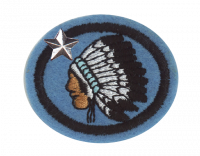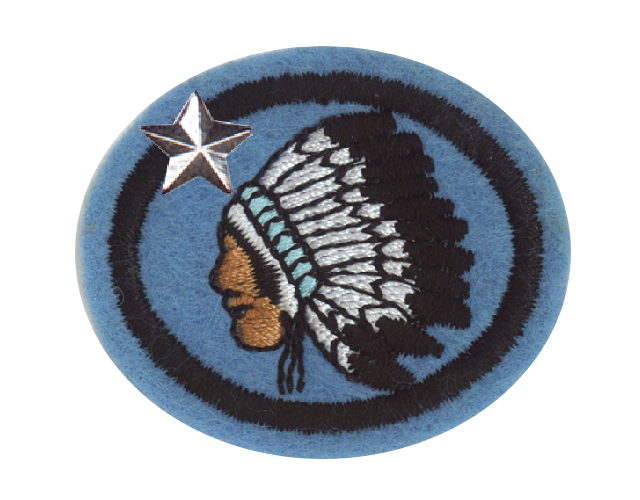Difference between revisions of "AY Honors/Native American Lore - Advanced/Answer Key/es"
From Pathfinder Wiki
< AY Honors | Native American Lore - AdvancedAY Honors/Native American Lore - Advanced/Answer Key/es
(Created page with "<noinclude>") |
|||
| (5 intermediate revisions by 2 users not shown) | |||
| Line 1: | Line 1: | ||
{{HonorSubpage}} | {{HonorSubpage}} | ||
| − | + | ||
{{ansreq|page={{#titleparts:{{PAGENAME}}|2|1}}|num=1}} | {{ansreq|page={{#titleparts:{{PAGENAME}}|2|1}}|num=1}} | ||
<noinclude></noinclude> | <noinclude></noinclude> | ||
| Line 11: | Line 11: | ||
<noinclude></noinclude> | <noinclude></noinclude> | ||
<!-- 2. Conocer y tener una lista de al menos 40 alimentos que fueron presentados por los dos. Conocer y tener una lista de al menos 40 alimentos que fueron presentados por los indígenas de Norteamérica y de Sudamérica. --> | <!-- 2. Conocer y tener una lista de al menos 40 alimentos que fueron presentados por los dos. Conocer y tener una lista de al menos 40 alimentos que fueron presentados por los indígenas de Norteamérica y de Sudamérica. --> | ||
| − | {{: | + | {{:AY Honors/Native American Foods/es}} |
<noinclude></noinclude> | <noinclude></noinclude> | ||
| Line 26: | Line 26: | ||
{{CloseReq}} <!-- 3 --> | {{CloseReq}} <!-- 3 --> | ||
{{ansreq|page={{#titleparts:{{PAGENAME}}|2|1}}|num=4}} | {{ansreq|page={{#titleparts:{{PAGENAME}}|2|1}}|num=4}} | ||
| − | <noinclude> | + | <noinclude></noinclude> |
| − | </noinclude> | + | <!-- 4. Nombrar cinco drogas o plantas medicinales utilizadas por los indígenas. --> |
| − | <!-- 4. | ||
| − | |||
| − | |||
{{clear}} | {{clear}} | ||
| Line 45: | Line 42: | ||
{{CloseReq}} <!-- 4 --> | {{CloseReq}} <!-- 4 --> | ||
{{ansreq|page={{#titleparts:{{PAGENAME}}|2|1}}|num=5}} | {{ansreq|page={{#titleparts:{{PAGENAME}}|2|1}}|num=5}} | ||
| − | <noinclude> | + | <noinclude></noinclude> |
| − | </noinclude> | + | <!-- 5. Discutir con respecto a los indígenas de su área sobre: a. Tribus localizados allí b. Hogares y las prendas de vestir c. Artesanía nativa realizada como: cestería, cerámica, alfombras, etc. d. Las prácticas religiosas e. Forma de gobierno --> |
| − | <!-- 5. | + | |
| − | |||
| − | |||
{{clear}} | {{clear}} | ||
| − | |||
| − | |||
{{clear}} | {{clear}} | ||
| − | |||
| − | |||
| − | |||
| − | |||
| − | |||
| − | |||
{{clear}} | {{clear}} | ||
| Line 174: | Line 161: | ||
{{CloseReq}} <!-- 5 --> | {{CloseReq}} <!-- 5 --> | ||
{{ansreq|page={{#titleparts:{{PAGENAME}}|2|1}}|num=6}} | {{ansreq|page={{#titleparts:{{PAGENAME}}|2|1}}|num=6}} | ||
| − | <noinclude> | + | <noinclude></noinclude> |
| − | </noinclude> | + | <!-- 6. Nombrar 10 objetos utilizados por los indígenas en sus ceremonias religiosas. --> |
| − | <!-- 6. | ||
| − | |||
| − | |||
| − | |||
| − | |||
| − | |||
| − | |||
| − | |||
| − | |||
| − | |||
| − | |||
| − | |||
| − | |||
| − | |||
<noinclude></noinclude> | <noinclude></noinclude> | ||
{{CloseReq}} <!-- 6 --> | {{CloseReq}} <!-- 6 --> | ||
{{ansreq|page={{#titleparts:{{PAGENAME}}|2|1}}|num=7}} | {{ansreq|page={{#titleparts:{{PAGENAME}}|2|1}}|num=7}} | ||
| − | <noinclude> | + | <noinclude></noinclude> |
| − | </noinclude> | + | <!-- 7. Explicar dos métodos del montaje y exhibición de flechas. --> |
| − | <!-- 7. | ||
| − | |||
| − | |||
<noinclude></noinclude> | <noinclude></noinclude> | ||
{{CloseReq}} <!-- 7 --> | {{CloseReq}} <!-- 7 --> | ||
{{ansreq|page={{#titleparts:{{PAGENAME}}|2|1}}|num=8}} | {{ansreq|page={{#titleparts:{{PAGENAME}}|2|1}}|num=8}} | ||
| − | <noinclude> | + | <noinclude></noinclude> |
| − | </noinclude> | + | <!-- 8. Explicar un método de restauración y reparación de flechas, ollas, mantas y cestas dañadas. --> |
| − | <!-- 8. | ||
| − | |||
| − | |||
| − | |||
| − | |||
{{clear}} | {{clear}} | ||
| Line 230: | Line 195: | ||
{{CloseReq}} <!-- 8 --> | {{CloseReq}} <!-- 8 --> | ||
{{ansreq|page={{#titleparts:{{PAGENAME}}|2|1}}|num=9}} | {{ansreq|page={{#titleparts:{{PAGENAME}}|2|1}}|num=9}} | ||
| − | <noinclude> | + | <noinclude></noinclude> |
| − | </noinclude> | + | <!-- 9. Nombrar y localizar al menos 10 diferentes tribus en la actualidad y decir por qué cada una sobre sale. --> |
| − | <!-- 9. | ||
| − | |||
| − | |||
<noinclude></noinclude> | <noinclude></noinclude> | ||
{{CloseReq}} <!-- 9 --> | {{CloseReq}} <!-- 9 --> | ||
{{ansreq|page={{#titleparts:{{PAGENAME}}|2|1}}|num=10}} | {{ansreq|page={{#titleparts:{{PAGENAME}}|2|1}}|num=10}} | ||
| − | <noinclude> | + | <noinclude></noinclude> |
| − | </noinclude> | + | <!-- 10. Experimentar con tintes de plantas utilizados por los indígenas y tratar de obtener al menos dos tonos de color. --> |
| − | <!-- 10. | + | ===El proceso de teñir=== |
| − | === | + | {{:AY Honors/Natural dyes/es}} |
| − | {{: | ||
| − | |||
{{clear}} | {{clear}} | ||
| Line 253: | Line 213: | ||
{{CloseReq}} <!-- 10 --> | {{CloseReq}} <!-- 10 --> | ||
{{ansreq|page={{#titleparts:{{PAGENAME}}|2|1}}|num=11}} | {{ansreq|page={{#titleparts:{{PAGENAME}}|2|1}}|num=11}} | ||
| − | <noinclude> | + | <noinclude></noinclude> |
| − | </noinclude> | + | <!-- 11. Realizar una de las siguientes actividades: --> |
| − | <!-- 11. | + | <noinclude></noinclude> |
| − | <noinclude | ||
| − | |||
{{ansreq|page={{#titleparts:{{PAGENAME}}|2|1}}|num=11a}} | {{ansreq|page={{#titleparts:{{PAGENAME}}|2|1}}|num=11a}} | ||
<noinclude></noinclude> | <noinclude></noinclude> | ||
| Line 264: | Line 222: | ||
{{CloseReq}} <!-- 11a --> | {{CloseReq}} <!-- 11a --> | ||
{{ansreq|page={{#titleparts:{{PAGENAME}}|2|1}}|num=11b}} <!--T:86--> | {{ansreq|page={{#titleparts:{{PAGENAME}}|2|1}}|num=11b}} <!--T:86--> | ||
| − | <noinclude> | + | <noinclude></noinclude> |
| − | </noinclude | ||
| − | |||
| − | |||
<noinclude></noinclude> | <noinclude></noinclude> | ||
{{CloseReq}} <!-- 11b --> | {{CloseReq}} <!-- 11b --> | ||
{{ansreq|page={{#titleparts:{{PAGENAME}}|2|1}}|num=11c}} <!--T:87--> | {{ansreq|page={{#titleparts:{{PAGENAME}}|2|1}}|num=11c}} <!--T:87--> | ||
| − | <noinclude> | + | <noinclude></noinclude> |
| − | </noinclude | ||
| − | |||
| − | |||
| − | + | <noinclude></noinclude> | |
| − | <noinclude | ||
| − | |||
{{CloseReq}} <!-- 11c --> | {{CloseReq}} <!-- 11c --> | ||
{{ansreq|page={{#titleparts:{{PAGENAME}}|2|1}}|num=11d}} <!--T:88--> | {{ansreq|page={{#titleparts:{{PAGENAME}}|2|1}}|num=11d}} <!--T:88--> | ||
| − | <noinclude> | + | <noinclude></noinclude> |
| − | </noinclude | ||
| − | |||
| − | |||
| − | + | <noinclude></noinclude> | |
| − | <noinclude | ||
| − | |||
{{CloseReq}} <!-- 11d --> | {{CloseReq}} <!-- 11d --> | ||
{{CloseReq}} <!-- 11 --> | {{CloseReq}} <!-- 11 --> | ||
| − | <noinclude> | + | <noinclude></noinclude> |
| − | </noinclude> | + | ==Referencias== |
| − | == | + | <noinclude></noinclude> |
| − | |||
| − | |||
| − | |||
| − | <noinclude | ||
| − | |||
{{CloseHonorPage}} | {{CloseHonorPage}} | ||
Latest revision as of 00:47, 26 July 2022
Artes y trabajos indígenas - Avanzado
Nivel de destreza
2
Año
1976
Version
03.12.2025
Autoridad de aprobación
Asociación General
1
Tener la especialidad de Artes y trabajos indígenas.
Para consejos e instrucciones, véase Artes y trabajos indígenas.
2
Conocer y tener una lista de al menos 40 alimentos que fueron presentados por los dos. Conocer y tener una lista de al menos 40 alimentos que fueron presentados por los indígenas de Norteamérica y de Sudamérica.
3
Participar en una comida utilizando la mayor cantidad de alimentos y métodos de cocción indígena como sean posibles.
4
Nombrar cinco drogas o plantas medicinales utilizadas por los indígenas.
5
Discutir con respecto a los indígenas de su área sobre:
- a. Tribus localizados allí
- b. Hogares y las prendas de vestir
- c. Artesanía nativa realizada como: cestería, cerámica, alfombras, etc.
- d. Las prácticas religiosas
- e. Forma de gobierno
6
Nombrar 10 objetos utilizados por los indígenas en sus ceremonias religiosas.
7
Explicar dos métodos del montaje y exhibición de flechas.
8
Explicar un método de restauración y reparación de flechas, ollas, mantas y cestas dañadas.
9
Nombrar y localizar al menos 10 diferentes tribus en la actualidad y decir por qué cada una sobre sale.
10
Experimentar con tintes de plantas utilizados por los indígenas y tratar de obtener al menos dos tonos de color.
11
Realizar una de las siguientes actividades:
11a
Visitar un museo de indígenas
11b
Visitar ruinas indígenas o montículos
11c
Hacer una visita personal a un indígena
11d
Visitar un pueblo indígena o reserva


